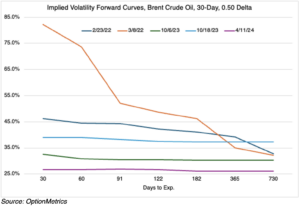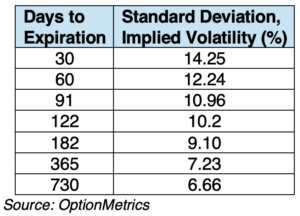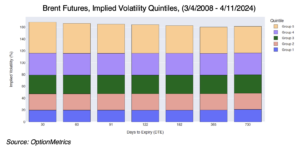The most recent geopolitical events in the Middle East have thrust crude oil back into the news. As of April 15, front month Brent crude was up almost 17% year-to-date. If the situation worsens, and the region slips into a wider war, a test of the psychologically important $100 level and beyond is not out of the question.
Less reported are crude’s implied volatility and the factors that are influencing it currently. Futures, with individual contract months and their related options, extending months to years in advance, allow forward price and implied volatility curves to be constructed. Since implied volatility is, in one regard, a measure of future uncertainty and anxiety, and forward volatility and price curves may be constructed, they can be used to help us understand the long term effects on the market from geopolitical events and how they change over time. Since crude oil has been buffeted by such shocks since the start of the war in Ukraine over two years ago, and has only recently been subjected to even more turmoil, it is a case in point.
To illustrate this, we used the OptionMetrics IvyDB Futures database to compile Brent crude oil futures data and implied volatilities since March 4, 2008. For each date, we examine continuous futures and options contracts with fixed 1, 2, 3, 4, 6, 12, and 24 month expirations and put and call deltas ranging from 0.10 to 0.50. We then produce forward price and implied volatility curves, as well as at-the-money to out-of-the-money skews, for the initial phase of the last two major geopolitical events to affect crude oil, the war in Ukraine (02/23/22 – 03/08/22), the war in the Middle East (10/07/23 – 10/18/23), and a more current date (4/11/24). We then compare the market’s reaction to each event.
Our results are summarized in the table below:
The implied volatility curves for each date are worth examining in more detail, as it is apparent that the implied volatility reaction to the war in Ukraine was much larger and extended further into the curve than that of the war in the Middle East.
Several observations:
- Not surprisingly, the market’s reaction to the beginning of the wars was an immediate steepening in crude oil’s price and implied volatility curves. For all of the dates, reviewed, both curves were backwardated, i.e., the near expiration values are greater than the deferred. However, after the initial shock of the geopolitical event wore off, both curves flattened out rather quickly.
- From the standpoint of both price, implied volatility, and skew, the reaction to the first phases of the war in Ukraine was significantly greater than that of the war in the Middle East. Ukraine was the first geopolitical shock to hit the crude market in some time. By the time war broke out in the Middle East last October 7, the market was accustomed to geopolitical turmoil and more skeptical that conflict could lead to supply disruption. You can see this further in one measure of geopolitical risk, the GPR index. During the beginning of the war in Ukraine, it peaked at 540.9; immediately after October 7, it peaked at 338.9.
- In most market conditions, crude oil implied volatility is inversely related to its underlying price. However, geopolitical events, especially those that are not well forecasted and consequently shock the market, can upend this relationship. In the case of both wars, the initial reaction was to buy crude and implied volatility, temporarily suspending the normally inverse relationship between the two.
- As a side note, and of particular interest to implied volatility spread traders, the data corroborates that the front end of the implied volatility curve shifts more than the back end. This is evident by calculating the average standard deviation of 30-day implied volatilities across various expirations:
- As evidenced by the quintile display below, the peak volatilities experienced during both wars (Ukraine, 89.3%; Middle East, 40.3%) were not extraordinary (i.e., by crude oil standards).
What does all this mean for the current crude market? Mostly, that the effect of geopolitical events on crude oil tends to lessen as multiple events occur concurrently, especially if major supply disruptions do not occur. This tends to simultaneously flatten and shift lower both the price and implied volatility curves. Markets are easily bored and require new information to keep focused on a specific fundamental, no matter how important or grave the topic. If no new geopolitical events are forthcoming, the crude markets may have to renew their focus on traditional supply and demand factors.
Prajwal Pitlehra, a FRE candidate at the NYU Tandon School of Financial Engineering, assisted in the production of this article.



